RS Aggarwal Class 9 Chapter Lines & Angles Exercise 4C Solution
EXERCISE 4C
Question 1:
Since AB and CD are given to be parallel lines and t is a transversal.
So, ∠5 = ∠1 = 70o [Corresponding angles are equal]
∠3 = ∠1 = 70o [Vertically opp. Angles]
∠3 + ∠6 = 180o [Co-interior angles on same side]
∴ ∠6 = 180o – ∠3
= 180o – 70o = 110o
∠6 = ∠8 [Vertically opp. Angles]
⇒ ∠8 = 110o
⇒ ∠4 + ∠5 = 180o [Co-interior angles on same side]
∠4 = 180o – 70o = 110o
∠2 = ∠4 = 110o [ Vertically opposite angles]
∠5 = ∠7 [Vertically opposite angles]
So, ∠7 = 70o
∴ ∠2 = 110o, ∠3 = 70o , ∠4 = 110o, ∠5 =
70o, ∠6 = 110o, ∠7 = 70o and ∠8 = 110o.
Question 2:
Since ∠2 : ∠1 = 5 : 4.
Let ∠2 and ∠1 be 5x and 4x respectively.
Now, ∠2 + ∠1 = 180o , because ∠2 and ∠1 form a linear pair.
So, 5x + 4x = 180o
⇒ 9x = 180o
⇒ x = 20o
∴ ∠1 = 4x = 4 × 20o = 80o
And ∠2 = 5x = 5 × 20o = 100o
∠3 = ∠1 = 80o [Vertically opposite angles]
And ∠4 = ∠2 = 100o [Vertically opposite angles]
∠1 = ∠5 and ∠2 = ∠6 [Corresponding angles]
So, ∠5 = 80o and ∠6 = 100o
∠8 = ∠6 = 100o [Vertically opposite angles]
And ∠7 = ∠5 = 80o [Vertically opposite angles]
Thus, ∠1 = 80o, ∠2 = 100o, ∠3 = ∠80o, ∠4 =
100o, ∠5 = 80o, ∠6 = 100o, ∠7 = 80o and
∠8 = 100o.
Question 3:
Given: AB || CD and AD || BC
To Prove: ∠ADC = ∠ABC
Proof: Since AB || CD and AD is a transversal. So sum of consecutive interior angles
is 180o.
⇒ ∠BAD + ∠ADC = 180o ….(i)
Also, AD || BC and AB is transversal.
So, ∠BAD + ∠ABC = 180o ….(ii)
From (i) and (ii) we get:
∠BAD + ∠ADC = ∠BAD + ∠ABC
⇒ ∠ADC = ∠ABC (Proved)
Question 4:
(i) Through E draw EG || CD. Now since EG||CD and ED is a transversal.
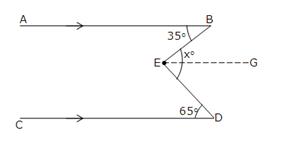
So, ∠GED = ∠EDC = 65o [Alternate interior angles]
Since EG || CD and AB || CD,
EG||AB and EB is transversal.
So, ∠BEG = ∠ABE = 35o [Alternate interior angles]
So, ∠DEB = xo
⇒ ∠BEG + ∠GED = 35o + 65o = 100o.
Hence, x = 100.
(ii) Through O draw OF||CD.
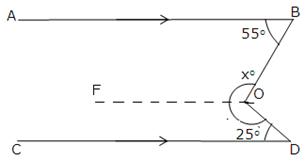
Now since OF || CD and OD is transversal.
∠CDO + ∠FOD = 180o
[sum of consecutive interior angles is 180o]
⇒ 25o + ∠FOD = 180o
⇒ ∠FOD = 180o – 25o = 155o
As OF || CD and AB || CD [Given]
Thus, OF || AB and OB is a transversal.
So, ∠ABO + ∠FOB = 180o [sum of consecutive interior angles is
180o]
⇒ 55o + ∠FOB = 180o
⇒ ∠FOB = 180o – 55o = 125o
Now, xo = ∠FOB + ∠FOD = 125o + 155o =
280o.
Hence, x = 280.
(iii) Through E, draw EF || CD.
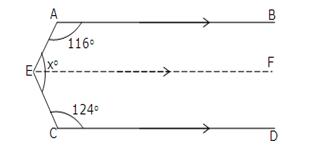
Now since EF || CD and EC is transversal.
∠FEC + ∠ECD = 180o
[sum of consecutive interior angles is 180o]
⇒ ∠FEC + 124o = 180o
⇒ ∠FEC = 180o – 124o = 56o
Since EF || CD and AB ||CD
So, EF || AB and AE is a trasveral.
So, ∠BAE + ∠FEA = 180o
[sum of consecutive interior angles is 180o]
∴ 116o + ∠FEA = 180o
⇒ ∠FEA = 180o – 116o = 64o
Thus, xo = ∠FEA + ∠FEC
= 64o + 56o = 120o.
Hence, x = 120.
Question 5:
Since AB || CD and BC is a transversal.
So, ∠ABC = ∠BCD [atternate interior angles]
⇒ 70o = xo + ∠ECD ….(i)
Now, CD || EF and CE is transversal.
So, ∠ECD + ∠CEF = 180o [sum of consecutive interior angles is
180o]
∴ ∠ECD + 130o = 180o
⇒ ∠ECD = 180o – 130o = 50o
Putting ∠ECD = 50o in (i) we get,
70o = xo + 50o
⇒ x = 70 – 50 = 20
Question 6:
Through C draw FG || AE
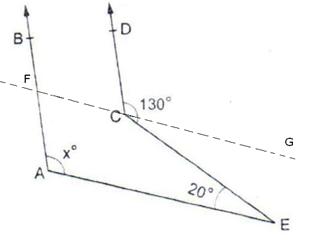
Now, since CG || BE and CE is a transversal.
So, ∠GCE = ∠CEA = 20o [Alternate angles]
∴ ∠DCG = 130o – ∠GCE
= 130o – 20o = 110o
Also, we have AB || CD and FG is a transversal.
So, ∠BFC = ∠DCG = 110o [Corresponding angles]
As, FG || AE, AF is a transversal.
∠BFG = ∠FAE [Corresponding angles]
∴ xo = ∠FAE = 110o.
Hence, x = 110
Question 7:
Given: AB || CD
To Prove: ∠BAE – ∠DCE = ∠AEC
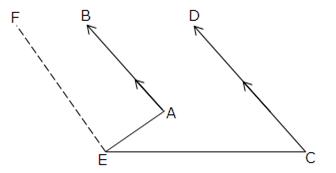
Construction : Through E draw EF || AB
Proof : Since EF || AB, AE is a transversal.
So, ∠BAE + ∠AEF = 180O ….(i)
[sum of consecutive interior angles is 180o]
As EF || AB and AB || CD [Given]
So, EF || CD and EC is a transversal.
So, ∠FEC + ∠DCE = 180o ….(ii)
[sum of consecutive interior angles is 180o]
From (i) and (ii) we get,
∠BAE + ∠AEF = ∠FEC + ∠DCE
⇒ ∠BAE – ∠DCE = ∠FEC – ∠AEF = ∠AEC [Proved]
Question 8:
Since AB || CD and BC is a transversal.
So, ∠BCD = ∠ABC = xo [Alternate angles]
As BC || ED and CD is a transversal.
∠BCD + ∠EDC = 180o
⇒ ∠BCD + 75o =180o
⇒ ∠BCD = 180o – 75o = 105o
∠ABC = 105o [since ∠BCD = ∠ABC]
∴ xo = ∠ABC = 105o
Hence, x = 105.
Question 9:
Through F, draw KH || AB || CD
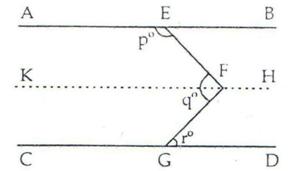
Now, KF || CD and FG is a transversal.
⇒ ∠KFG = ∠FGD = ro …. (i)
[alternate angles]
Again AE || KF, and EF is a transversal.
So, ∠AEF + ∠KFE = 180o
∠KFE = 180o – po …. (ii)
Adding (i) and (ii) we get,
∠KFG + ∠KFE = 180 – p + r
⇒ ∠EFG = 180 – p + r
⇒ q = 180 – p + r
i.e., p + q – r = 180
Question 10:

Since AB || PQ and EF is a transversal.
So, ∠CEB = ∠EFQ [Corresponding angles]
⇒ ∠EFQ = 75o
⇒ ∠EFG + ∠GFQ = 75o
⇒ 25o + yo = 75o
⇒ y = 75 – 25 = 50
Also, ∠BEF + ∠EFQ = 180o [sum of consecutive interior angles is
180o]
∠BEF = 180o – ∠EFQ
= 180o – 75o
∠BEF = 105o
∴ ∠FEG + ∠GEB = ∠BEF = 105o
⇒ ∠FEG = 105o – ∠GEB = 105o – 20o =
85o
In ∆EFG we have,
xo + 25o + ∠FEG = 180o

Hence, x = 70.
Question 11:
Since AB || CD and AC is a transversal.
So, ∠BAC + ∠ACD = 180o [sum of consecutive interior angles is
180o]
⇒ ∠ACD = 180o – ∠BAC
= 180o – 75o = 105o
⇒ ∠ECF = ∠ACD [Vertically opposite angles]
∠ECF = 105o
Now in ∆CEF,
∠ECF + ∠CEF + ∠EFC =180o
⇒ 105o + xo + 30o = 180o
⇒ x = 180 – 30 – 105 = 45
Hence, x = 45.
Question 12:
Since AB || CD and PQ a transversal.
So, ∠PEF = ∠EGH [Corresponding angles]
⇒ ∠EGH = 85o
∠EGH and ∠QGH form a linear pair.
So, ∠EGH + ∠QGH = 180o
⇒ ∠QGH = 180o – 85o = 95o
Similarly, ∠GHQ + 115o = 180o
⇒ ∠GHQ = 180o – 115o = 65o
In ∆GHQ, we have,
xo + 65o + 95o = 180o
⇒ x = 180 – 65 – 95 = 180 – 160
∴ x = 20
Question 13:
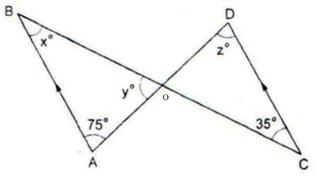
Since AB || CD and BC is a transversal.
So, ∠ABC = ∠BCD
⇒ x = 35
Also, AB || CD and AD is a transversal.
So, ∠BAD = ∠ADC
⇒ z = 75
In ∆ABO, we have,
∠AOB + ∠BAO + ∠BOA = 180o
⇒ xo + 75o + yo = 180o
⇒ 35 + 75 + y = 180
⇒ y = 180 – 110 = 70
∴ x = 35, y = 70 and z = 75.
Question 14:
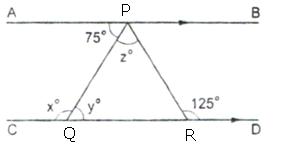
Since AB || CD and PQ is a transversal.
So, y = 75 [Alternate angle]
Since PQ is a transversal and AB || CD, so x + APQ = 180o
[Sum of consecutive interior angles]
⇒ xo = 180o – APQ
⇒ x = 180 – 75 = 105
Also, AB || CD and PR is a transversal.
So, ∠APR = ∠PRD [Alternate angle]
⇒ ∠APQ + ∠QPR = ∠PRD [Since ∠APR = ∠APQ + ∠QPR]
⇒ 75o + zo = 125o
⇒ z = 125 – 75 = 50
∴ x = 105, y = 75 and z = 50.
Question 15:
∠PRQ = xo = 60o [vertically opposite angles]
Since EF || GH, and RQ is a transversal.
So, ∠x = ∠y [Alternate angles]
⇒ y = 60
AB || CD and PR is a transversal.
So, ∠PRD = ∠APR [Alternate angles]
⇒ ∠PRQ + ∠QRD = ∠APR [since ∠PRD = ∠PRQ + ∠QRD]
⇒ x + ∠QRD = 110o
⇒ ∠QRD = 110o – 60o = 50o
In ∆QRS, we have,
∠QRD + to + yo = 180o
⇒ 50 + t + 60 = 180
⇒ t = 180 – 110 = 70
Since, AB || CD and GH is a transversal
So, zo = to = 70o [Alternate angles]
∴ x = 60 , y = 60, z = 70 and t = 70
Question 16:
(i) Lines l and m will be parallel if 3x – 20 = 2x + 10
[Since, if corresponding angles are equal, lines are parallel]
⇒ 3x – 2x = 10 + 20
⇒ x = 30
(ii) Lines will be parallel if (3x + 5)o + 4xo =
180o
[if sum of pairs of consecutive interior angles is 180o, the lines are
parallel]
So, (3x + 5) + 4x = 180
⇒ 3x + 5 + 4x = 180
⇒ 7x = 180 – 5 = 175
⇒ x = \(\frac { 175 }{ 7 } \) = 25
Question 17:
Given: Two lines m and n are perpendicular to a given line l.
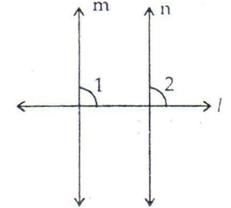
To Prove: m || n
Proof : Since m ⊥ l
So, ∠1 = 90o
Again, since n ⊥ l
∠2 = 90o
∴ ∠1 = ∠2 = 90o
But ∠1 and ∠2 are the corresponding angles made by the transversal l with lines m
and n and they are proved to be equal.
Thus, m || n.